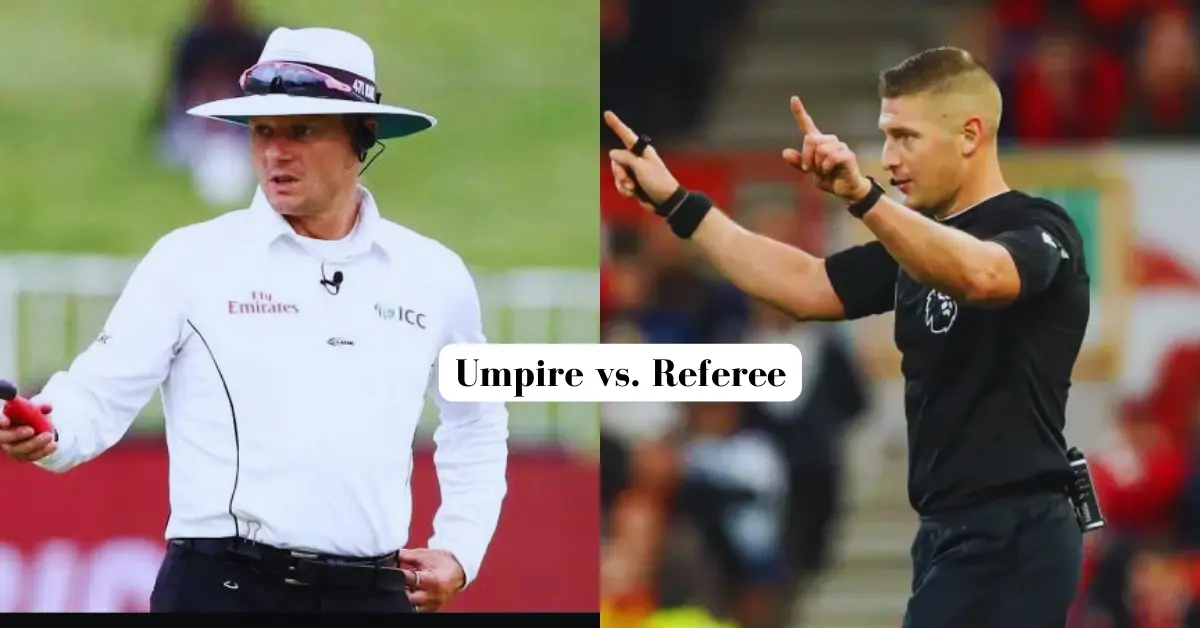Umpire vs. Referee: Difference, Compression & Roles
In the dynamic world of sports, we often hear the terms “umpire” and “referee” used interchangeably. However, these two roles play distinct and crucial parts in ensuring fair play and upholding the rules of various sports. This article will delve into the differences and similarities between Umpire vs. Referee the challenges they face, their training, iconic figures in these roles, and the evolving nature of their positions.
The Table For Comparing The Roles Of Referees And Umpires In Sports
| Aspect | Referee | Umpire |
|---|---|---|
| Sports | Commonly found in soccer, basketball, football, and many team sports. | Mainly linked with activities such as cricket, baseball, and tennis. |
| Responsibilities | Enforce the rules, manage player behavior, and ensure a fair and safe environment. | Make decisions on the field, such as judging whether a batsman is out or if a ball is in or out of bounds. |
| Jurisdiction | Oversee the entire match, including player fouls, game time, and penalties. | Authority is often limited to specific aspects of the game, such as pitch conditions, player conduct, and ball movements. |
| Communication | Interact with players, coaches, and the audience, explaining their decisions and maintaining control over the match. | Primarily use hand signals to convey decisions, making their rulings more concise and less dependent on verbal communication. |
| Training | Extensive knowledge of the rules, excellent decision-making skills, and often certification. | In-depth understanding of specific sport’s rules, often requiring certification and experience. |
| Notable Examples | In soccer, the FIFA World Cup features renowned referees like Pierluigi Collina. | In cricket, figures like Simon Taufel and Dickie Bird are celebrated umpires. |
Umpire: The Game Guardian
Umpires bear the main responsibility of ensuring fair play and adherence to the rules during the game.In sports like cricket, their role is pivotal, as they make crucial decisions on issues such as LBW (leg before wicket) and boundary calls. The decisions made by an umpire can have a profound impact on the outcome of a game, making their role a matter of great responsibility. See Also: 10 Best Cricket Umpires of All Time

Referee: The Rule Enforcer

Referees, on the other hand, focus on enforcing the rules of the game. Soccer is a sport where the referee’s decisions often dictate the flow of the game. They issue yellow and red cards, make offside calls, and ensure players adhere to the rulebook. Their primary function is to maintain discipline and uphold the integrity of the game.
Key Differences Between Umpire vs. Referee

If we talk about the key difference between Umpire vs. Referee. The roles of umpires and referees differ significantly. Umpires make judgment calls, such as deciding if a cricket batsman is out, whereas referees strictly enforce the rules of the game, like penalizing players for fouls in soccer. However, both roles share common aspects, such as ensuring neutrality and fair play.
Similarities
In some sports, both umpires and referees may coexist, each having their specific responsibilities. For example, in tennis, there is an umpire who oversees scoring and line calls, while a referee manages player conduct and rule enforcement. Neutrality is a common denominator in both roles, as they should not show favoritism to any team or player.
Challenges Faced
Umpires and referees face numerous challenges. They must make split-second decisions under immense pressure, often in the presence of passionate fans and players. Handling criticism and maintaining composure during intense moments are essential skills for success in these roles.
Training and Qualifications
To become a professional umpire or referee, individuals typically need to undergo specific training and acquire relevant qualifications. These requirements vary from sport to sport, but ongoing education and certification are necessary to stay updated with rule changes and officiating techniques.
Iconic Umpires and Referees
The world of sports officiating has seen its fair share of iconic figures. Cricket enthusiasts remember names like Simon Taufel, while soccer fans hold Pierluigi Collina in high regard. These individuals have established a commendable standard for aspiring umpires and referees, displaying outstanding skills and unwavering commitment.
Evolution of the Roles
Umpiring and refereeing have evolved with the advancements in technology. Innovations like Hawkeye in cricket and Video Assistant Referee (VAR) in soccer have changed the way decisions are made. While technology has improved accuracy, it has also sparked debates about the role of human judgment in sports. See Also: Top 10 Greatest Soccer Players
Umpire vs. Referee: A Comparison

Distinguishing a good umpire from a good referee can be challenging. Umpires rely on their judgment to make decisions, often in real-time, while referees focus on rule enforcement. Situations where the roles overlap, such as in tennis, highlight the importance of effective communication and cooperation between officials.
Sportsmanship and Fair Play
Referees and umpires hold a crucial role in encouraging sportsmanship and fair play. Through their decisions, they exemplify values of respect and integrity, setting a positive standard for both players and fans in the sports community.
Technology’s Influence
Technology has brought both advantages and challenges to sports officiating. Video replay and VAR have improved decision accuracy, but discussions about the “human element” and the impact of technology on the flow of the game persist.
Umpire and Referee Etiquette
Professionalism is paramount for umpires and referees. They must manage player and coach interactions, maintain composure, and ensure the game proceeds smoothly. How officials conduct themselves can influence the overall atmosphere of a match.
Career Prospects
For those passionate about sports and equipped with the necessary skills, a career in umpiring or refereeing can be fulfilling. Opportunities for advancement, specialization, and even international recognition exist for dedicated officials.
Difference Between Umpire And Referee In Cricket

In cricket, it’s crucial to differentiate between an umpire and a referee. Umpires focus on on-field decisions, ensuring fair play by judging LBW appeals, boundary calls, and dismissals. Meanwhile, referees have a wider role, overseeing the game’s conduct, dealing with player discipline, and upholding the match’s integrity.
Umpires handle in-game decisions, while referees maintain the game’s order and spirit. Both play essential roles in the cricketing world, and understanding their unique responsibilities is key to grasping the sport’s dynamics. See Also: What is a Free Hit in Cricket?
FAQs
No, their roles vary depending on the sport’s rules and requirements.
Qualifications vary by sport, but training and certification are typically required.
Technology has improved decision accuracy but raised questions about the impact of the “human element.”
Yes, many iconic figures have made a significant impact on sports officiating.
Yes, dedicated officials have the potential to gain international recognition and officiate at the highest levels of their respective sports.
Conclusion
In the realm of sports, umpires and referees have separate but connected jobs. Umpires make calls, and referees enforce rules, ensuring fairness. In today’s tech-driven world, the discussion on human vs. tech officiating emphasizes their crucial roles in sports.







